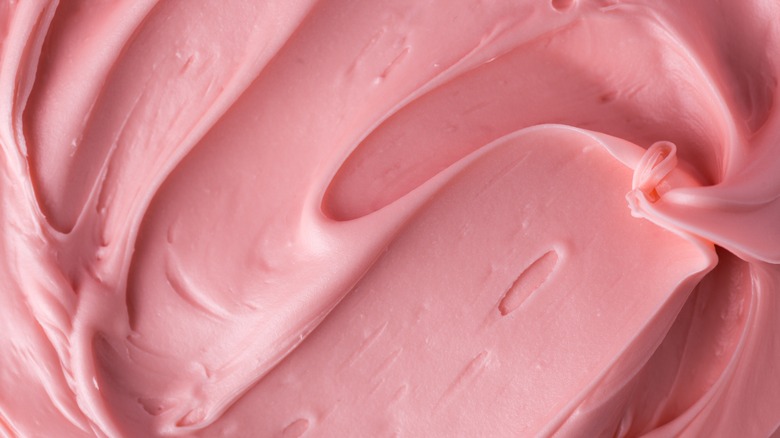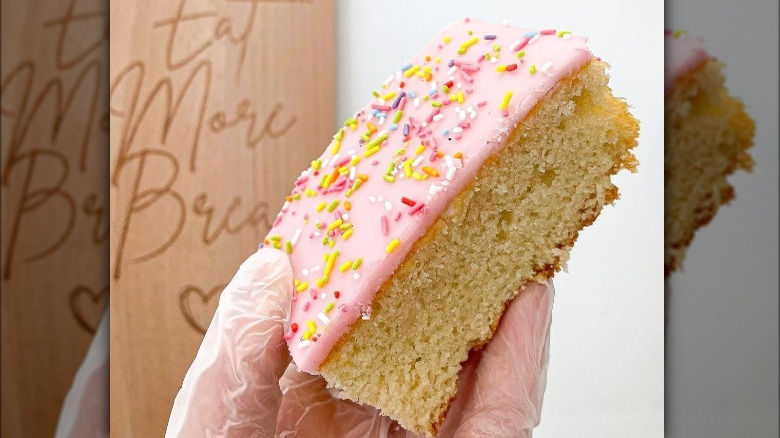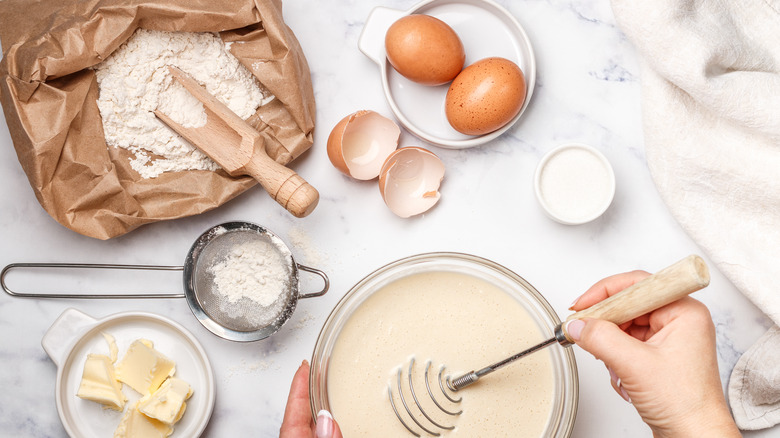Tottenham Cake: London's Historic Pink Sweet Treat
Britain may have a roster full of oddly-named desserts (spotted dick, anyone?), but it isn't short of sweets that have unique origin stories either. The pink and white, checkerboard-patterned Battenberg cake is said to have been created in 1884 to mark the wedding of Prince Louis of Battenberg to Princess Victoria, per Taste Atlas. Famed chef Auguste Escoffier created the flaming poached cherry and vanilla ice cream dessert known as Cherries Jubilee for Queen Victoria's Diamond Jubilee in 1897.
But not all British desserts have such illustrious origin stories. According to The Old Original Bakewell Pudding Shop, the Bakewell tart was created by accident when a Derbyshire cook neglected to stir the eggs into the pastry, so they poured them on top of jam instead. And then there's the distinctive, pink-colored Tottenham cake, first created in the 1800s by a Quaker baker named Henry Chalkley who lived in the North London district of Tottenham, per Sainsbury's Magazine.
History of the Tottenham cake
Henry Chalkley was said to have been inspired to create this hot pink-colored treat for the children of Tottenham, and then sold them for a penny a cube or oddly-shaped slices for half the price (via The London Economic).
Not only were the cakes inexpensive to buy, but they were also economical to make, which embodied the Quaker values of simplicity and equality. The cake's bright pink icing came from mulberries grown at the Quakers' Meeting House facility in Tottenham, and which were said to have fallen off the tree. Coconut was sometimes sprinkled over the top, although the chewy shreds weren't always welcomed by some Quakers who had false teeth, per Haringey London.
Tottenham cake has ties to more than just the North London Quakers — it's linked to the city's soccer club, the Tottenham Hotspurs, too. According to The London Economic, when the club won its first-ever FA Cup Final in 1901, the cake was given free to all the children in the area. While the cakes continue to be made by Quakers to this day, the cake re-entered modern-day pop culture when it was reintroduced by "The Great British Bake Off" in 2013, per Haringey London.
How to make and serve Tottenham cakes
Tottenham cakes are classified as traybakes – a type of sheet cake that bakes up as a cake, but is treated, for the most part, like an easy-to-make bar cookie, per Cookist. And while the cakes have kept their bright pink frosting, they are generally no longer made with mulberries from the trees found at the Quaker Meeting House, today they are either dyed pink using food coloring or by using mashed raspberries, according to Sainsbury's Magazine.
To make Tottenham cakes, you need the recipe for a simple sponge cake, which is made with sugar, eggs, butter, vanilla, self-raising flour, baking powder, milk, and orange zest, per Sainsbury's Magazine, although one version found in Haringey London makes use of an optional touch of nutmeg, and another calls for the use of dried currants, which are similar to raisins. The ingredients for the bright pink frosting vary as well — with one recipe calling for mulberry, blackcurrant, or cherry juice, and the other calling for a dash of peppermint. The cakes are then decorated with the signature pink icing with an optional sprinkle of coconut.
The cakes may cost more than a penny today, and the bakeshop best known for making the Tottenham cake may have shut its doors in 2020, per Roman Road London, but the tradition of making Tottenham cakes continues to this day.


